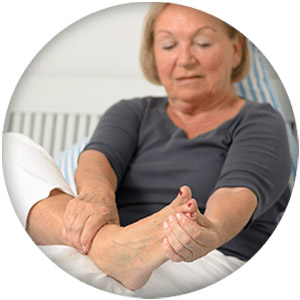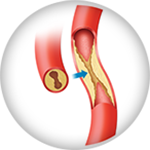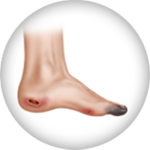Pain at Rest

Symptom Details
Although pain at rest can happen anytime, it typically occurs at night during sleep. People may awaken to severe burning sensations in their lower legs or feet, which may become chronic and persistent. This pain may be temporarily relieved by hanging a foot or leg over the bed. When a person experiences pain at rest, it can signify a severe blockage in the arteries of the lower extremities.2 The blockage happens when the arteries become narrowed and hardened due to excessive plaque build-up and can significantly reduce blood flow to the area. Pain at rest can be a sign of advanced peripheral artery disease, also called critical limb ischemia (CLI).3 Over time, pain at rest can lead to more serious complications, such as tissue loss and leg ulcers. The skin can break down and develop non-healing wounds.1 Therefore, it is critical to take the step and see your doctor right away if you experience this symptom. This is how pain at rest symptoms typically progress: 1,2,3
Mild
Moderate
Severe
Causes
Pain at rest is a result of progressive and chronic blockage of the arteries to the legs and feet. When your body does not get the healthy blood flow it needs, pain may occur. With a chronic lack of oxygen to the tissue, the skin can begin to break down and form leg ulcers, or other types of non-healing wounds. As the lack of blood flow progresses, the area may not heal and can lead to limb amputation or other complications.5
Risk Factors

Although PVD diseases range in symptoms and causes, they all carry certain risk factors. For pain at rest, in addition to vascular conditions, other risk factors include:3
What to Look For
Pain at rest does not usually begin on its own. Instead, the condition may stem from untreated peripheral artery disease (PAD). The Rutherford Classification is a common system that is widely used to diagnose and identify the severity of arterial disease. Here are how the symptoms progress:
Rutherford Classification 6
| Stage 0 | Stage 1 | Stage 2 | Stage 3 | Stage 4 | Stage 5 | Stage 6 |
| No symptoms | Some exercise pain after walking long distances | Exercise pain that occurs more frequently at shorter distances | Severe exercise pain that happens frequently after a short distance | Pain in the legs, calves, buttocks that occurs despite rest | Leg ulcers begin to develop | Severe non‑healing wounds can lead to gangrene or tissue loss |
If you notice signs of advanced artery disease, it is important to see your doctor right away as the condition requires immediate care.4
Associated Symptoms
Exercise Pain
A common early symptom of PAD is exercise pain, or arterial claudication which produces cramping pain or discomfort in the legs, thighs, feet or buttocks.
Non-healing wounds
Poor blood circulation can lead to skin break down, open wounds, or ulcers, that require prompt medical attention. When the sores are open, they allow for bacteria and air to enter the wound, which can make the condition worse.
Gangrene
When blood flow to the toes is cut off, tissue can die and turn black. This is called gangrene and it can lead to tissue loss or amputation.
When to See a Doctor
Exercise pain may be a sign of a serious venous or arterial disease. Appropriate treatment of these conditions is important not only to prevent progression of disease. If you notice intermittent pain in your legs during exercise, it is important to take the step to get help right away. Talk to your doctor, or use our tool to locate a doctor to consult for a diagnosis.
Helpful Resources

PVD Doctor
Discussion Guide
Get helpful tips and advice on how to talk to your doctor about a PVD screening.

Patient Brochures
Third-Party Resources
Helpful Websites
Blogs
Apps
A mobile app built by cardiologists, to simplify understanding of most cardiac and peripheral vascular conditions and treatments.
Find a Doctor
If you think you are experiencing pain at rest, it is important to get help. Talk to your doctor, or use our tool below to find a specialist near you.
This tool is not inclusive of all specialists. Consult with your insurance provider to find specialists that are covered within your network.
Are You a Healthcare Professional?
Find out how to register your practice with us.
1.“Critical Limb Ischemia.” Vascular Cures. VascularCures.org. n.d. 2.“Symptoms and Causes of Peripheral Artery Disease.” Mayo Clinic. Mayo Foundation for Medical Education and Research. Dec. 24, 2015. 3.“Critical limb ischemia.” UC Davis Vascular Center. n.d. 4.“What is Peripheral Artery Disease?” National Institutes of Health. U.S. Department of Health and Human Services. June 22, 2016. 5.Varu et al. “Critical limb schema.” Journal for Vascular Surgery. Volume 51, Issue 1, Pages 230–241. Jan. 2010. 6.Hardman et al. “Overview of Classification Systems in Peripheral Artery Disease.” Semin Intervent Radiol. 2014 Dec; 31(4): 378–388.
Disclaimer
The opinions and clinical experiences presented herein are for informational purposes only. Individual results may vary depending on a variety of patient-specific attributes and related factors. Dr. Raghu Kolluri has been compensated by Philips for his services in preparing and providing this material for Philips further use and distribution. We offer links to third-party websites that may be of interest to our website visitors and in no way, represent any affiliation or endorsement of the information provided on those linked websites. These links are provided solely for your convenience and to assist you in learning more information on this topic. However, Philips does not control, endorse or guarantee the accuracy of the information contained on the linked sites. In addition, Philips makes no representations or warranties of any kind with regards to any third-party websites or information contained therein. If you have any questions or concerns about the information on the linked third-party websites, please contact the third-party websites directly.




